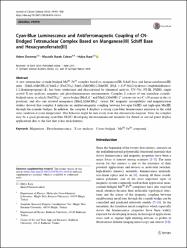Cyan-Blue Luminescence and Antiferromagnetic Coupling of CN-Bridged Tetranuclear Complex Based on Manganese(III) Schiff Base and Hexacyanoferrate(III)
Özet
A new tetranuclear cyanide-bridged Mn-III-Fe-III complex based on manganese(III) Schiff base and hexacyanoferrate(III) units, [Mn(L)(MeOH)(2)][{Mn(L)}{Fe(CN)(6)}{Mn(L)(MeOH)}]center dot 2MeOH, [H2L=N,N'-bis(2-hydroxy-1-naphthalidenato)-1,2-diaminopropane] (1), has been synthesized and characterized by elemental analysis, UV-Vis, FT-IR, PXRD, single crystal X-ray analyses, magnetic and photoluminescence measurements. Complex 1 consist of one trinuclear cyanido-bridged anion, in which [Fe(CN)(6)](3-) anion bridge [Mn(L)](+) and Mn(L)(MeOH)}](+) cations via two C equivalent to N groups in the cis positions, and also one isolated manganese [Mn(L)(MeOH)(2)](+) cation. DC magnetic susceptibility and magnetization studies showed that complex 1 indicates an antiferromagnetic coupling between low-spin Fe(III) and high-spin Mn(III) through the cyanide bridges. In addition, the complex 1 displays a strong cyan-blue luminescence emission in the solid state condition at room temperature. This behavior might be seen easily from the chromaticity diagram. Thus, the complex may be a good promising cyan-blue OLED developing electroluminescent materials for flatted or curved panel display applications due to the fact that it has such features.


















